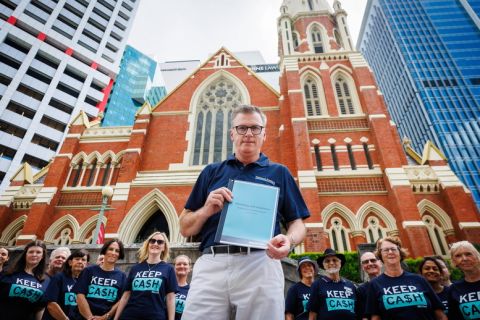Older Australians face housing debt burden
A new report wants new housing models and less ageist bank lending policies.

Key points
Report finds older Australians less likely to own their homes, struggle to buy into the market and face rising rents.
The mortgage debt burden for older Australians has surged 600% over the past 30 years.
National Seniors and the report recommend innovative solutions for better and affordable housing.
It’s not only younger people who are struggling to put a roof over their heads.
Over the past two decades, the circumstances of older Australians seeking affordable housing have deteriorated significantly, with home ownership rates plummeting and a rising number of retirees saddled with mortgage debt as they enter retirement.
Additionally, access to social housing has worsened, leaving many vulnerable older citizens in a precarious situation, a new report has found.
The Australian Housing and Urban Research Institute (AHURI) report into the challenges faced by older Australians on lower incomes estimates 440,000 older households will be unable to find or afford suitable housing by 2031.
The research also revealed the mortgage debt burden for older Australians has surged 600% over the past three decades, worsening their already precarious financial situation.
The study revealed older Australians were increasingly using their superannuation funds to pay off mortgage debts, potentially affecting their quality of life as they age.
This has led to a rising number of defaults on mortgage repayments, pushing a significant proportion of middle-aged and older households out of home ownership.
The study found lower income older people wanted housing that was achievable, affordable, safe, secure and in familiar neighbourhoods.
Older households were surveyed about alternative housing models. There was a clear preference for a shared equity home ownership model, a cooperative housing model and a transportable housing model, and land lease model, which AHURI says reflects the expectation that it is “normal” to own one’s home in Australia.
In a land lease arrangement, households own their dwellings but not the land, making them eligible for Commonwealth Rent Assistance and improving housing affordability.
Low-income older householders who can’t afford any form of mortgage are having to pay a large proportion of their income on rent.
AHURI says if they could get a loan there are two options that “have the potential to deliver forms of home ownership, with the security of tenure and wellbeing that provides”. These are: shared equity mortgages and land lease mortgages.
Lead author and University of South Australia researcher, Dr Debbie Faulkner, said the preference for shared equity models stems from the deeply ingrained cultural norm of home ownership in Australia.
“The subdued response to the other options we presented indicates people’s long-entrenched aspirations and a lack of familiarity older people have with ‘alternative’ housing options,” Dr Faulkner said.
The reluctance of banks to provide mortgages for alternative housing models is perceived as a major hurdle to older people entering the housing market.
Dr Faulkner criticised this, saying banks readily lend for depreciating assets such as cars but hesitate to support secure housing arrangements for older citizens.
“Not all buyers have sufficient cash to purchase a land lease home, but some could support a small mortgage as a way of obtaining security of tenure and preserving their capital,” Dr Faulkner said.
She said this further exacerbates the challenges faced by older Australians in securing stable housing, forcing them to rely on government equity partners that “will need to be patient before they recoup their investments on the future sale or transfer of the property”.
National Seniors fights for better housing
National Seniors Australia’s Better Housing advocacy campaign is lobbying the government to support age-friendly, affordable housing for seniors.
The key policies are:
Enable home care recipients to downsize without pension penalties.
Introduce a stamp duty concession for eligible seniors in all states and territories.
Include accessible housing design standards in the National Construction Code (NCC), which will make new housing age-friendly and facilitate more downsizing options.
Create a capital grants scheme for the construction of rental housing suitable for older people.
National retirement village legislation. We are calling for strengthened and nationally uniform laws for retirement villages to ensure the rights of older people are protected.
The report also raised concerns over the decline in home ownership for older households and called for regulatory changes to better support alternative housing market expansion.
For example, the report noted that responsible lending obligations have created a “conservative lending environment”, where age is seen as grounds for refusing a mortgage. The report suggested that assumptions about an applicant's capacity to service a loan should be examined.
It also suggested financial regulators could study the patterns of income and consumption of older people as well as loan defaults and rent arrears to understand the risk of lending to this age cohort and the ramifications of not servicing this cohort.
In addition, initiatives like Nightingale Housing’s ‘Teilhaus’ apartments, which promote non-speculative owner-occupation and social connection, were supported by mortgage lenders. However, once settlement neared, some lenders were less enthusiastic.
However, it highlighted micro-apartments as a potential solution to the housing crisis for older Australians.
Regional centres also offer options for the development of low-density housing and could cater to people seeking more secure and lower cost and lower-risk housing solutions.
Predictions to 2031 suggest the shift of older lower-income renters to outer suburbs and major regional centres.
These include Orange North, Muswellbrook, and Maitland West in NSW; Horsham, Shepparton, Ballarat North, and Wodonga in Victoria; Victor Harbour, Port Lincoln, and Murray Bridge in South Australia; Albany and Busselton in Western Australia; and Sorell-Richmond in Tasmania.
Related reading: AHURI, Mortgage Business








